 Excavations in Chavín in 1955 BACKGROUND : The domain of the ceremonial complexes (temples), with the purpose of appropriating the agricultural productive surplus and controlling the work force for the priests, accelerated the development of the productive forces; especially of the hydraulic techniques and the direction of agriculture; this with the help of "astronomical observatories", as well as a greater specialization of work. This resulted in the development of social relations (of exploitation) and the legitimization of the appropriation of the means of production (land, canals, scientific knowledge, etc.) by the priestly class. Such ceremonial complexes flourished in various regions of the Andes, predominating in the north and center. Among those we must mention:• Caral (Supe, Lima):Recently considered the first Andean State • Cotosh (Huanuco):The oldest known sanctuary. • Chuquitanta (Lima):Called "El Paraíso". • Pacopampa (Cajamarca) • Kunturwasi (Cajamarca) • Sechin (Ancash) • Galgada (Ancash) • Chavín de Huántar (Ancash) • Poemape (Lambayeque )
Excavations in Chavín in 1955 BACKGROUND : The domain of the ceremonial complexes (temples), with the purpose of appropriating the agricultural productive surplus and controlling the work force for the priests, accelerated the development of the productive forces; especially of the hydraulic techniques and the direction of agriculture; this with the help of "astronomical observatories", as well as a greater specialization of work. This resulted in the development of social relations (of exploitation) and the legitimization of the appropriation of the means of production (land, canals, scientific knowledge, etc.) by the priestly class. Such ceremonial complexes flourished in various regions of the Andes, predominating in the north and center. Among those we must mention:• Caral (Supe, Lima):Recently considered the first Andean State • Cotosh (Huanuco):The oldest known sanctuary. • Chuquitanta (Lima):Called "El Paraíso". • Pacopampa (Cajamarca) • Kunturwasi (Cajamarca) • Sechin (Ancash) • Galgada (Ancash) • Chavín de Huántar (Ancash) • Poemape (Lambayeque )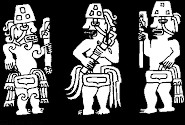 Sechín, chavinoid style CHAVÍN SOCIETY: More than 3000 years ago, the Andean inhabitants entered a process of great transformations. Production exceeded the limits of self-consumption, due to specialized agriculture, since the priests controlled production; this is how a material advance was obtained, and at the same time new contradictions were established:the workers were oppressed by their leaders and the specialists in astronomy became the privileged ones. This period is called Formative, which began with Cotos, Kunturwasi, Garagay, Sechín and reached its synthesis and apogee with Chavín.
Sechín, chavinoid style CHAVÍN SOCIETY: More than 3000 years ago, the Andean inhabitants entered a process of great transformations. Production exceeded the limits of self-consumption, due to specialized agriculture, since the priests controlled production; this is how a material advance was obtained, and at the same time new contradictions were established:the workers were oppressed by their leaders and the specialists in astronomy became the privileged ones. This period is called Formative, which began with Cotos, Kunturwasi, Garagay, Sechín and reached its synthesis and apogee with Chavín. LOCATION: The Chavín settlement is located between the Mosna and Huachecsa rivers, to the east of the Cordillera Blanca in the heart of the Quechua region, at 3,177 meters above sea level, in the Conchucos alley. The Chavinian domain reached the inter-Andean lands, the coast with its coastlines and was undeniably linked to the High Forest. Many valleys, low and high, were worked with great efficiency. The Chavín expansion reached the current departments of Ica and Ayacucho, to the south; to the east, the Huallaga basin; Tumbes and Cajamarca, to the north. Already at this time the men of the Andes had managed to control the development of many plants and manage the breeding and domestication of camelids, through refined techniques in order to satisfy their needs. The Chavín culture developed between 1200 B.C. to 200 A.D. The chronicler Cieza de León arrived at this place, however it was Julio C. Tello who was the true discoverer (1919).
 Location and territorial extension reached by Chavín ORIGINS: Although Julio C. Tello described Chavín as a "Matrix Culture", the truth is that a thousand years before agricultural villages arose on the central coast, such as Sechín Alto and Sechín Bajo, which have left us architectural and sculptural complexes with war scenes and samples of a bureaucratic organization that suggests a relationship between the two cultures:Sechín and Chavín. Likewise, in Cotosh, Huaricoto and La Galgada belonging to the Ancash - Huánuco axis, villages were developed, also agricultural, which as a whole bear similarities with the Chavín culture and deserve greater attention by Peruvian archeology to clarify the respective links and continue with the affirmation of an Andean cultural synthesis that later spread to all the Andes in the north, center and south of present-day Peru. Chavín influenced various cultures such as Paracas, Nazca and Tiahuanaco, as well as the centers of Cupisñique (La Libertad, Sechín (Ancash), Chongoyape (Lambayeque) and Vicus (Piura)1. Chavinoid ceramics in Piura. 2. Objects with Chavín decoration in gold and other materials. Chongoyape, Chiclayo. 3. Pacopampa ceremonial center (Chota, Cajamarca). 4. Chavinoid-style tombs, (Jequetepeque). 5. Kuntur Ceremonial Center - Wasi (Cajamarca) 6. Kotosh (Chavín phase) in Huánuco. 7. Dead Horse Center; with murals (Trujillo). 8. Numerous ceremonial centers in Casma (Mojeque, Punkuri...). 9. Ceremonial centers throughout the central coast between Huarmey - Lima. 10. Chavinoid painted fabrics (Ica). 11. Ceramics with Chavinoid designs (Paracas).
Location and territorial extension reached by Chavín ORIGINS: Although Julio C. Tello described Chavín as a "Matrix Culture", the truth is that a thousand years before agricultural villages arose on the central coast, such as Sechín Alto and Sechín Bajo, which have left us architectural and sculptural complexes with war scenes and samples of a bureaucratic organization that suggests a relationship between the two cultures:Sechín and Chavín. Likewise, in Cotosh, Huaricoto and La Galgada belonging to the Ancash - Huánuco axis, villages were developed, also agricultural, which as a whole bear similarities with the Chavín culture and deserve greater attention by Peruvian archeology to clarify the respective links and continue with the affirmation of an Andean cultural synthesis that later spread to all the Andes in the north, center and south of present-day Peru. Chavín influenced various cultures such as Paracas, Nazca and Tiahuanaco, as well as the centers of Cupisñique (La Libertad, Sechín (Ancash), Chongoyape (Lambayeque) and Vicus (Piura)1. Chavinoid ceramics in Piura. 2. Objects with Chavín decoration in gold and other materials. Chongoyape, Chiclayo. 3. Pacopampa ceremonial center (Chota, Cajamarca). 4. Chavinoid-style tombs, (Jequetepeque). 5. Kuntur Ceremonial Center - Wasi (Cajamarca) 6. Kotosh (Chavín phase) in Huánuco. 7. Dead Horse Center; with murals (Trujillo). 8. Numerous ceremonial centers in Casma (Mojeque, Punkuri...). 9. Ceremonial centers throughout the central coast between Huarmey - Lima. 10. Chavinoid painted fabrics (Ica). 11. Ceramics with Chavinoid designs (Paracas). Based on the remains found, Tello determined that Chavín originated due to the influence of jungle peoples and considered it the mother culture of Peru. For this Peruvian scholar, it was the culture from which the other Peruvian cultures originated, which, with certain modifications, based their religious system on the cult of the feline. Currently, it has been determined that this is not the case. In the Andean territory, cultures such as Garagay, Kunturhuasi, Sechín, Caral, etc., long before Chavín, developed. The importance of the Chavín culture lies in the fact that it represents a synthesis of the cultures that developed earlier. It was a culture that acquired the contributions of previous cultures, and spread them throughout a large part of the Andean territory.
ECONOMY: In approximately 800 BC, agriculture was the main activity in the Andes; because the cultivation of corn, cotton, pacay, beans had spread and developed; moreover, the domain over nature was concretized in the channeling of water, diverting water from the river towards the cultivated fields; the work of Cumbemayo (Cajamarca) is an example of this. In the Andes, agricultural work was done using terrace techniques that retain soil fertility, prevent erosion and allow for rational use of water, and the soil was turned over with the chaquitaclla, which is a simple foot plough. They used the force of large human groups; while they improved the domestication and breeding of camelids and guinea pigs. They achieved a varied and rich diet with products of different types from the Chala, Yunga and Quechua zones. "The labor forces were represented by peasants, shepherds, artisans, stonecutters - builders, potters, metallurgists - goldsmiths and weavers; by those who worked on the land cultivating quinoa, corn, peppers, peanuts, lima beans, yucca, etc., and in the raising of auquenid cattle, such as llamas and alpacas.The instruments they used were forks, hoes, ropes, pens, ovens, molds, needles, balls of yarn, etc. The production relations were therefore classist or unequal; because a social minority patented in the militaristic priesthood took over the land, men, animals and artisanal agricultural production. The specialists or priests did not participate directly in the work; they only dedicated themselves to planning. The peasants worked in the countryside and the artisans did it inside the temples that were a kind of manufacturing workshops. Both social sectors were exploited under slave conditions" (Vargas Salg ado – 1987).
SOCIAL AND POLITICAL ORGANIZATION: In Chavín society, new types of social relations appeared, since the ayllus (already consolidated collective family) basically needed guidance in the use of water; for this they had to know the cycles of rains, droughts, floods, floods and low water. This need led them to choose certain characters to dedicate themselves to the study of natural problems, which further generated specialties at work. Although they managed to identify astral movements and natural phenomena, they took advantage of their knowledge to demand tribute from the peasants, arguing that they were intermediaries of the Sun or the rains that the people considered gods. This is how the social division in the Chavín culture is intensifying. While the peasants work and produce for themselves and for the authorities, the specialists direct the work, demand tributes of food, wool, women and order the construction of temples where they reside with great privileges.
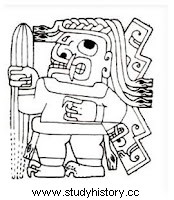 The priests – astronomers who supervised the work and centralized the production of peasants and artisans, organized a theocratic State, to defend themselves from possible rebellions, through militiamen, who were trained to dismember their opponents, as shown in the engravings of the monolithic stelae of Sechin; they also preached a religious ideology of a terrifying and threatening nature to strengthen their domination over the workers. These priests are considered, therefore, the first dominant social class in ancient Peru that organized beliefs in animal deities such as the anaconda, the otorongo and the harpy; Amazonian animals that were represented in stones and fabrics to spread them as a catechism to the peoples they controlled.
The priests – astronomers who supervised the work and centralized the production of peasants and artisans, organized a theocratic State, to defend themselves from possible rebellions, through militiamen, who were trained to dismember their opponents, as shown in the engravings of the monolithic stelae of Sechin; they also preached a religious ideology of a terrifying and threatening nature to strengthen their domination over the workers. These priests are considered, therefore, the first dominant social class in ancient Peru that organized beliefs in animal deities such as the anaconda, the otorongo and the harpy; Amazonian animals that were represented in stones and fabrics to spread them as a catechism to the peoples they controlled. Principal Priest of Chavín. Illustration Bruno Alva CULTURAL EXPRESSIONS: CERAMIC: The need to conserve seeds, grains and water led the people of Chavin to make clay pots, already practiced in Guañape and Huánuco (Huayrajirca). They made their pottery in a globular shape and with a handle or neck with a stony appearance; the motifs were represented with a punch, using the incision technique, were figures of deified felines, which the authorities ordered to represent in order to spread their religion and cause fear in the population. Chavín ceramics were monochrome and the color black predominated, in most of the production of ceramics that were obtained through the smoking technique in (closed ovens) they were for ceremonial use. It was used as an offering to the gods, for this reason they are called ceremonial holes. It was monochrome because it has only one color, which could be black or gray (very similar to stone). In terms of its shape, it has a flat base, a globular body, a stirrup handle and a neck-shaped spout. On its surface, incised representations of their gods were made, especially the jaguar.
Principal Priest of Chavín. Illustration Bruno Alva CULTURAL EXPRESSIONS: CERAMIC: The need to conserve seeds, grains and water led the people of Chavin to make clay pots, already practiced in Guañape and Huánuco (Huayrajirca). They made their pottery in a globular shape and with a handle or neck with a stony appearance; the motifs were represented with a punch, using the incision technique, were figures of deified felines, which the authorities ordered to represent in order to spread their religion and cause fear in the population. Chavín ceramics were monochrome and the color black predominated, in most of the production of ceramics that were obtained through the smoking technique in (closed ovens) they were for ceremonial use. It was used as an offering to the gods, for this reason they are called ceremonial holes. It was monochrome because it has only one color, which could be black or gray (very similar to stone). In terms of its shape, it has a flat base, a globular body, a stirrup handle and a neck-shaped spout. On its surface, incised representations of their gods were made, especially the jaguar.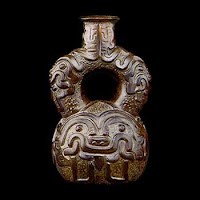
SCULPTURE: One of the wonders of this culture is the work on stone; the technique to polish the rocks and their transfer based on joint work; – all this was done by many men who served the theocratic state. In it they represented and glorified their gods, power, the fierceness of nature, with which they achieved ideological support before the community. For this reason, inside the Chavín de Huántar Temple they placed the sculpture of the Lanzón, with the figure of a menacing feline, nailed to the floor of a dark room. It is one of the best known sculptures of Chavín art. An elongated stone has been used. It measures 5.53 m. high and the material is white granite worked in bas-relief. It represents a man standing, with his left arm at his side and his right arm raised. His hands are open and represented as claws. He wears earrings, necklace, robe and belt. His hair is figured as snakes and his belt as a chain of faces (Bonavia - 1991). The material used to make the sculptures was stone. It was a monolithic sculpture, made based on a single stone. It became a means of representation and dissemination of the gods.
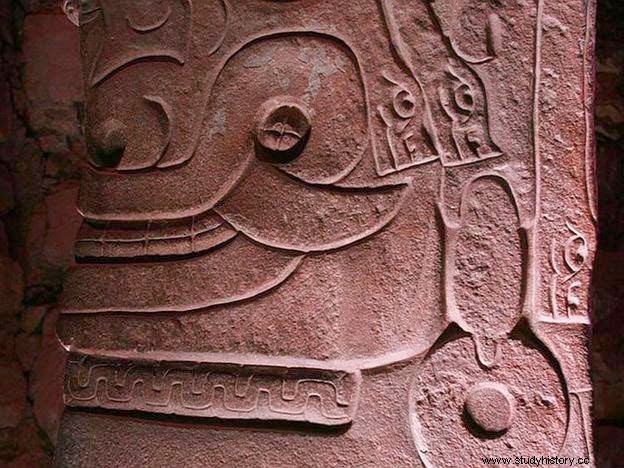 Monolithic lanzón-temple of Chavín de Huantar
Monolithic lanzón-temple of Chavín de Huantar 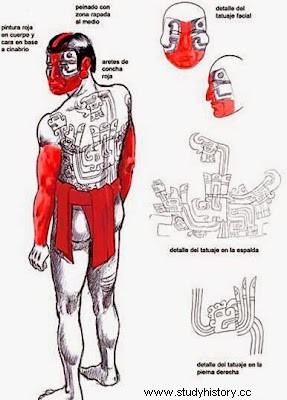 Male sculptor from Chavín:Illustration Bruno Alva
Male sculptor from Chavín:Illustration Bruno Alva 
The Stele that Raymondi unveiled, represents a mythological being, a mixture of feline and bird placed in a special room. It is rectangular in shape and measures 1.98 m long and 74 cm wide. In it, the god of staffs or rods is represented, who appears standing and carrying rods in both hands. On his head is represented a large headdress where features of snakes and felines are observed. His eyes look up.The cult of this divinity was widespread in later times in Chavín.
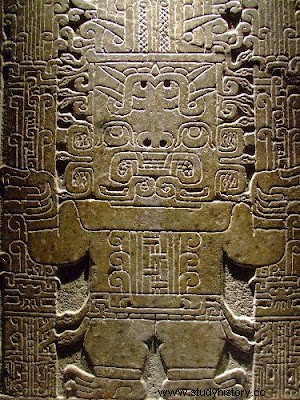 Raimondi Stela The nailheads Embedded in the first platform of the temple, they also carry a feline image, as if they were stone guardians. They were nailed to the outer walls of the Chavín temple. It is argued that they would be the guardians of it. Due to their anthropomorphic form, they would be representing the transformations of the priests into jaguars.
Raimondi Stela The nailheads Embedded in the first platform of the temple, they also carry a feline image, as if they were stone guardians. They were nailed to the outer walls of the Chavín temple. It is argued that they would be the guardians of it. Due to their anthropomorphic form, they would be representing the transformations of the priests into jaguars.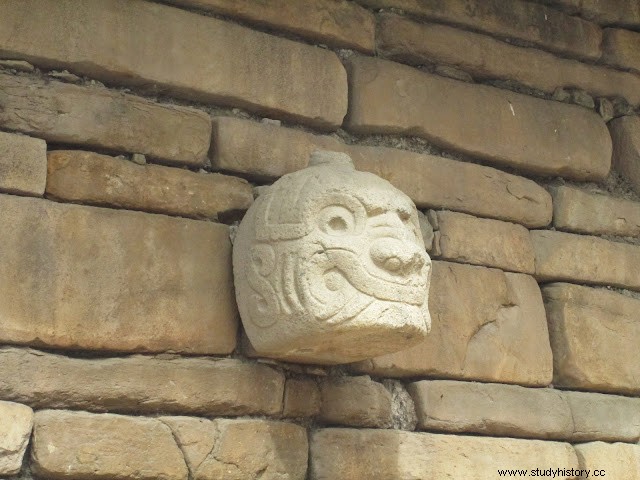 Head nails in its original position The so-called Tello Obelisk contains figures of an alligator and molluscs. The stone sculptures of Chavín also inform us about the important plants (or animals) used in healing practices, such as the San Pedro (Trichocereus pacharo), a cacti associated in traditional medicine with the jaguar, Car-Collins ( 1977) believes that in addition to its use in Chavín curandería, it is their symbol". That is why they represent it as a scepter and slices of San Pedro can be seen in the belly of the jaguar. In some tombstones "an anthropomorphic being appears with scepters and that , next to his mouth and nose, there are possibly coca leaves and "cat's claw" seeds (Anadenanthera colubrina) in which alkaloids of great hallucinogenic power have been discovered (Evans &Hoffman - 1982) (Quoted by Campana - 1993 ). It is a monolithic sculpture 2.5 m high. It seems that it was originally located in the central part of the plaza of the New Temple. In it, the divinity of the mythological caiman of the jungle with fish attributes appeared. The divinity appears decorated with motifs that would represent chili peppers, peanuts, yucca, felines, condors, snakes. It would be a divinity of fertility and the production of food plants. In Chavín it was also found carvings of deposits in the living rock in total 7 and distributed based on the location of the stars in space that has the shape of a feline called Orion constellation (Choquechinchay). According to Engineer Milla Villena, those wells were filled with water that then became astronomical mirrors where the images were inverted. Udima (Cajamarca), Tupe (Yauyos), Coricancha (Cusco), Machu Picchu and Tiahuanaco (great scientific ceremonial center) were found of this type of sculptures in living rock that were true mirrors of astronomical observation.
Head nails in its original position The so-called Tello Obelisk contains figures of an alligator and molluscs. The stone sculptures of Chavín also inform us about the important plants (or animals) used in healing practices, such as the San Pedro (Trichocereus pacharo), a cacti associated in traditional medicine with the jaguar, Car-Collins ( 1977) believes that in addition to its use in Chavín curandería, it is their symbol". That is why they represent it as a scepter and slices of San Pedro can be seen in the belly of the jaguar. In some tombstones "an anthropomorphic being appears with scepters and that , next to his mouth and nose, there are possibly coca leaves and "cat's claw" seeds (Anadenanthera colubrina) in which alkaloids of great hallucinogenic power have been discovered (Evans &Hoffman - 1982) (Quoted by Campana - 1993 ). It is a monolithic sculpture 2.5 m high. It seems that it was originally located in the central part of the plaza of the New Temple. In it, the divinity of the mythological caiman of the jungle with fish attributes appeared. The divinity appears decorated with motifs that would represent chili peppers, peanuts, yucca, felines, condors, snakes. It would be a divinity of fertility and the production of food plants. In Chavín it was also found carvings of deposits in the living rock in total 7 and distributed based on the location of the stars in space that has the shape of a feline called Orion constellation (Choquechinchay). According to Engineer Milla Villena, those wells were filled with water that then became astronomical mirrors where the images were inverted. Udima (Cajamarca), Tupe (Yauyos), Coricancha (Cusco), Machu Picchu and Tiahuanaco (great scientific ceremonial center) were found of this type of sculptures in living rock that were true mirrors of astronomical observation.
The archaeologist Rebeca Carrión Cachot - a disciple of Tello - from studies carried out managed to distinguish different types of sculpture :1. Obelisks 2. Monolithic Lanzón (Chavin Lanzón) in the temple of the same name. 3. Tombstones or stelae (Stela of Chavin or Raimondi). 4. Cornices 5. Nailheads (adorn temples). 6. Mortars 7. Stone Pots and Boxes
 Tello Obelisk
Tello Obelisk 
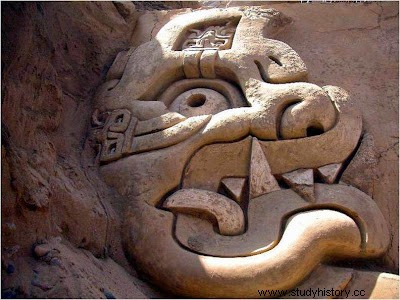 Chavinoid style The most famous works are the Cabezas Clavas which some archaeologists consider to be huge symbols of trophy heads. Its name (nail) comes from the fact that these heads end in an extension that, like a nail, allows the sculpture to be placed on the walls of buildings.
Chavinoid style The most famous works are the Cabezas Clavas which some archaeologists consider to be huge symbols of trophy heads. Its name (nail) comes from the fact that these heads end in an extension that, like a nail, allows the sculpture to be placed on the walls of buildings.ARCHITECTURE: The Chavín de Huantar theocracy achieved high prestige in astronomical knowledge which allowed it to strengthen its influence over the peasants of the coast, south and north. The power they were acquiring led them to build temples, and from there control the work in each region; production and corresponding taxation of peasants. Control was exercised through local authorities appointed by them. On the coast of Lima they used the temple of Garagay built of adobe; in the Andes of Cajamarca, of Kunturwasi (with galleries and aqueducts); in La Libertad they had Caballo Muerto; in Lambayeque, to Chongoyape; in Ayacucho, to Chupas; etc. The ceremonial nature of these rooms should be emphasized, but which, over time, became centers of urban occupation. It was characterized by the combined geometric shapes of its constructions, for example:truncated pyramid, patio, sunken wells, distribution of buildings. U-shaped, etc.; He also built underground buildings with labyrinth-type designs. The wonderful TEMPLE OF CHAVIN ceremonial center stands out, which was adorned with stone figures (clava heads). The material they used in the construction of their temples was stone and adobe, depending on the region where the construction was carried out. Generally, the temples built were in the shape of a "U" with circular or rectangular plazas. The Old Temple and the New Temple of Chavín de Huantar were the most important. All the followers of the Chavín religion came to them on pilgrimage to participate in the religious ceremonies that were organized and to offer offerings consisting of corn, mullu or spondyllus, ceramics and various objects of great value. The Old Temple presents interior galleries very similar to labyrinths and ventilation ducts. It does not have windows. They built canals to channel the water that passed under the squares, stairs and galleries. It has a circular square. In the New Temple they used columns and it has a sunken rectangular plaza.

 Secondary Priest of Chavín. Illustration Bruno Alva GOLDWORK: They came to use only gold and in the final phases of culture, copper. They used thick sheets as in the Kunturwasi necklace and the Chongoyape treasure (earrings, rings, nose rings, etc.). The jewels of the Chavín culture had applications of precious stones, they worked the technique of embossing felinoid figures on the sheets. They worked gold and silver. They developed techniques such as hammering, gilding, and silver plating. They made objects in the form of earmuffs, nose rings, etc. The representations they made were their main divinities.
Secondary Priest of Chavín. Illustration Bruno Alva GOLDWORK: They came to use only gold and in the final phases of culture, copper. They used thick sheets as in the Kunturwasi necklace and the Chongoyape treasure (earrings, rings, nose rings, etc.). The jewels of the Chavín culture had applications of precious stones, they worked the technique of embossing felinoid figures on the sheets. They worked gold and silver. They developed techniques such as hammering, gilding, and silver plating. They made objects in the form of earmuffs, nose rings, etc. The representations they made were their main divinities. Cupisnique crown, Chavinoid style
Cupisnique crown, Chavinoid style 